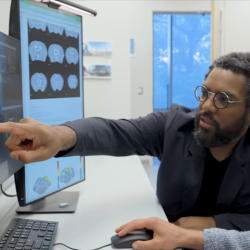Our Ever-Changing Environment
Like Clockwork for more than 40 years, each summer Biology Professor David Inouye heads to the Rocky Mountains to study the local wildflowers. “I head there after final exams in late May,” says Inouye. “I used to find the snow just beginning to melt and the flowers starting to bloom.” While the professor’s schedule remains the same, the flowering schedule has shifted due to changing environmental conditions brought about by climate change. Nowadays, more often than not, Inouye misses the onset of the flowering season and tasks a research assistant with gathering the early data.
Early-blooming flowers are just one of the many climate-change phenomena that CMNS researchers are exploring. Global climate models point to rising temperatures and increased variability in precipitation, which can set off a chain of environment-altering events, says Antonio Busalacchi, director of the college’s Earth System Science Interdisciplinary Center (ESSIC). Higher temperatures, which lead to melting polar ice caps and rising sea levels, are literally just the tip of the iceberg. “We can also expect to see more floods and droughts and more extreme weather events overall,” says Busalacchi. “The wet parts of the world are getting wetter, and the dry parts are getting drier.”
Changes from Land to Sea
The complex interplay between the physical environment and the biological world is triggering a host of changes in the environment, and the broad array of scientific expertise in CMNS translates to an impressive range of research on changes in the cryosphere, atmosphere, oceans and waterways, land surface, and marine and terrestrial ecosystems. “We now have an appreciation that these components, as well as human influence, are all coupled, and that there is feedback to the system,” says Busalacchi. “Within the next 50 years, we will likely produce accurate environmental forecasts that predict how the environment will change, be it from season to season or decade to decade.” In the meantime, CMNS researchers, representing the full range of expertise in the life sciences and physical sciences, are documenting significant environmental changes in plant life, animal domain, freshwater supply and disease virulence.
Winter Wildflowers and Rain-Soaked Penguins
Inouye attributes a 30-year-trend of earlier snow melt at his field site in Crested Butte, Col., some 9,500 feet above sea level, to a combination of global climate change and regional effects, such as El Niño cycles and northern Pacific Ocean temperatures.
This early snow melt causes a ripple of problems through the ecosystem. In the Rockies, the melting snow triggers wildflowers to bud. If a cold snap strikes, these early-forming buds may suffer frost damage, leading to a decline in wildflower population. That’s bad news for pollinators and for wildflower reproduction by seed.
Teaming up with a Stanford University researcher studying butterflies, Inouye discovered a correlation between wildflower abundance and butterfly population. “Without as much nectar, the butterflies lay fewer eggs,” he explains. A wildflower decline could impact a variety of organisms, including seed predators, flies that lay their eggs in the flowers, and animals up the food chain, Inouye hypothesizes. “The consequences of global climate change are showing up earlier and more strongly at high altitudes, like the Rockies, as well as at high latitudes,” he notes.
Antarctica is already facing environmental changes impacting its penguins, says Biology Professor Bill Fagan, who applies sophisticated statistical and spatial analysis to help quantify changes in penguin populations. Biology Postdoctoral Researcher Heather Lynch, who works with Fagan, explains: “Antarctica is transitioning from a cold, dry place to a warmer, wetter place.”
Lynch travels on commercial touring vessels throughout the Antarctic Peninsula to inventory three penguin species. “We are basically hitchhikers on tourist trips,” she explains. Although cruise ships provide easy access to study sites, there are challenges. “Sometimes we sail right by a site that is important to our research.” With NSF funding, Fagan’s lab provides the expertise to analyze the sporadic and patchy data collected. Specializing in spatial ecology, Fagan leads varied research projects around the globe that explore ecological patterns and dynamics—working to understand such issues as the ecological recovery of Mount St. Helens and the migration of Mongolian gazelles.
The researchers have found that two penguin species are declining, while the third group, the gentoos, are increasing. As temperatures rise, sea ice decreases, leading to a decline in krill, penguins’ major food source. “For now, the gentoos are a climate change winner, partly because they have a more flexible diet,” notes Lynch. “They eat fish in addition to krill.”
Just as climate change is shifting the flowering season in the Rockies, it alters penguin breeding schedules in Antarctica. Traditionally, the migrant Adélie penguins nest first, seeking out the best spots. But with the changing environmental cues, the local gentoos now arrive first and settle into the prime locations, “causing a shift in the balance of power,” says Lynch, who will be starting a faculty position at Stony Brook University in the fall.
Increased rainfall also causes breeding problems. “Penguins are set up to deal with snow, not rain,” Lynch says. Severe rain ravages their nests, causing the Adélie and chinstrap penguins to pack up for the season, while the gentoos re-establish their nests. “The gentoos are going gangbusters right now,” says Lynch, “but it is possible that in 30 years the krill decrease will catch up with them.”
Water Temperature on the Rise
Climate change and variability are also threatening the health of our waterways, a primary source for fresh water and seafood. Sujay Kaushal, an assistant professor in the Department of Geology and ESSIC, recently documented an alarming warming trend in U.S. rivers and streams. In a 2010 study funded by the NSF and Maryland Sea Grant, Kaushal and colleagues analyzed historical records of water temperatures of 40 U.S. rivers and streams and found that about half showed significant warming.
For example, temperatures rose an average of 0.046 degrees Celsius per year in Washington D.C.’s Potomac River from 1922 to 2006. In general, the largest temperature increases were found in waterways near urbanized areas. The increased temperatures stimulate the growth of algae and bacteria, which consume oxygen when they decompose. Rising water temperatures may also alter rates of nutrient cycling and reduce oxygen concentrations, further contributing to “dead zones”— low-oxygen areas where fish and other marine life struggle to survive, says Kaushal.
Margaret Palmer, professor of Entomology, with a partial appointment in the University of Maryland Center for Environmental Science (UMCES) and director of the new National Socio-Environmental Synthesis Center (SeSynC, see related story, p. 10), also studies the effects of climate change on rivers and streams. “If river water warms too quickly—say 3 to 4 degrees Celsius in the next 25 years—the organisms living there are unlikely to adapt fast enough,” says Palmer, who also serves as director of the university’s Chesapeake Biological Laboratory. “At first we will see declines in reproductive output or survival of the young. Over time, populations of some species will decline while those species able to withstand warmer water (often non-native species) will increase.”
Her research team has found the problem is magnified in small streams in urbanized areas where temperatures spike after a rainstorm. “Fifty years from now, these temperature spikes may be as high as 7 degrees Celsius and could last for hours. This would clearly exceed the thermal tolerance limits of many native fish,” says Palmer.
Cholera Outbreak in Haiti
Climate change may be partly responsible for the recent cholera outbreak in Haiti, says Rita Colwell, Distinguished University Professor at the University of Maryland Institute for Advanced Computer Studies (UMIACS) and National Medal of Science winner. In the 1980s, Colwell discovered that the bacterium that causes cholera, Vibrio cholerae, naturally occurs in the environment, identifying it in Bangladesh’s rivers and estuaries.
 She also found that the bacterium’s abundance is affected by climate. “This was a real paradigm shift,” she says. “Previously cholera was believed to be transmitted only from person to person.” Colwell dete
She also found that the bacterium’s abundance is affected by climate. “This was a real paradigm shift,” she says. “Previously cholera was believed to be transmitted only from person to person.” Colwell dete
rmined that the bacterium persists in the environment, for example, by attaching to zooplankton hosts. V. cholerae becomes dormant under adverse conditions and reverts to an
actively growing state in favorable conditions.
“V. cholerae becomes abundant when temperatures rise above 15 to 17 degrees Celsius,” explains Colwell, whose research on V. cholerae strains has taken her from Africa to Central America to the Chesapeake Bay. igher temperatures and increased sunlight spur photosynthesis, fostering phytoplankton growth and subsequent zooplankton grazing on phytoplankton, along with a rise in the V. cholerae bacterium. “With climate change, we can expect to have shorter winters and longer periods of time with higher temperatures, increasing the potential for more intense cholera outbreaks,” she notes.
Haiti’s catastrophic 2010 earthquake disrupted its river system, releasing limestone into the rivers and creating an alkaline environment that is favorable to V. cholerae growth, according to earthquake researchers. The following summer brought warmer than usual temperatures along with torrential flooding and turbulence due to Hurricane Tomas. “You have all the ingredients for the bacterium to flourish in a country with poor sanitation, a country where people drink water taken straight from the rivers and ponds. It was the perfect storm for a cholera epidemic,” says Colwell, who is sequencing Haiti’s V. cholerae genome. “This is a wakeup call: extreme weather events—which are becoming more frequent—provide the mechanisms for cholera outbreaks in countries with poor sanitation and lacking safe drinking water.”
Adapting to Climate Change
CMNS researchers are not only identifying the impact of climate change but are also developing ways to help society adapt. For example, Colwell has made significant strides in controlling the spread of cholera by introducing a simple filtration technique to villagers in Matlab, Bangladesh. She also has developed a prediction model using satellite imaging to detect potential outbreaks by looking at indicators such as sea temperature, sea height and chlorophyll concentrations. “We have created an important public health tool for this waterborne disease,” says Colwell, who hopes that future satellite data will also include variables such as oxygen saturation to improve the model’s accuracy.
Kaushal works to improve stormwater management and water shed restoration, advising local water resource managers on strategies to slow down and filter stormwater runoff before it flows into local streams. “Our job is not only to document the problems but also to propose and identify solutions to protect water quality and water quantity issues.” He works with the city of Baltimore on its sustainability plan as well as with Washington, D.C.’s Blue Plains Advanced Wastewater Treatment Plant, the largest advanced wastewater treatment plant in the world. He also works closely with the U.S. Geological Survey (USGS) and the Environmental Protection Agency (EPA).
A Triple-Threat to Malaria
Recent research suggests that warmer global temperatures are among the factors causing the mosquito-borne malaria parasite to migrate into previously unaffected areas. In hopes of slowing the spread of malaria, Entomology Professor Raymond St. Leger has developed a genetically modified fungus that kills the malaria parasite.
The finding, published this year in Science, grew out of St. Leger’s earlier work to combat malaria. Previously, St. Leger created a genetically modified fungus to attack the mosquitoes carrying malaria. “But the insects became resistant time and time again,” he describes, leading him to wonder: Why not attack the malaria directly? After much trial and error, his team developed a triple threat to the malaria virus—a genetically modified fungus with a human antibody gene, a scorpion anti-malarial gene, and a gene that blocks malaria’s access to the mosquito’s saliva glands.
“The fungus acts like a hypodermic,” explains St. Leger, whose work is supported by the National Institute of Allergy and Infectious Diseases, part of the National Institutes of Health. “It penetrates through the mosquito’s cuticle and injects the anti-malarial protein into the blood, basically curing the insects of malaria.” St. Leger’s team is also working on genetically modifying fungi to attack two other diseases that could be on the rise due to climate change—Lyme disease and the dengue virus.
Drought-Tolerant Designer Genes
June Kwak, associate professor in the Department of Cell Biology and Molecular Genetics, is looking at how plants respond to dry conditions in an effort to develop plants with enhanced drought tolerance and more efficient water usage. In extremely dry conditions, a plant synthesizes the hormone abscisic acid (ABA), which triggers its stomatal pores surrounded by a pair of guard cells to close and conserve water. Kwak’s research, in collaboration with colleagues from five other institutions, shows that certain mutant plants that are ABA-hypersensitive need less water to survive.
Knowing that ABA plays a key role in a plant’s drought tolerance, Kwak seeks to identify all the behind-the-scenes players at the molecular level that regulate stomatal closure in response to ABA. Recently, he identified two proteins—MPK9 and MPK12—that help regulate the guard-cell response. Without these proteins, plants fail to close their stomatal pores efficiently, making them more susceptible to drought, says Kwak, whose research is supported by the NSF and the U.S. Department of Agriculture (USDA). With the agricultural sector being the biggest consumer of freshwater worldwide, “the goal is to manipulate plants so that they are more tolerant to drought, and we can conserve our water resources.”
Modeling Climate Change
At the center of the university’s climate-change research is the Earth System Science Interdisciplinary Center (ESSIC), a world leader in developing Earth system models, with an emphasis on providing data for policymakers and stakeholders. Through a collaboration between the university’s Departments of Atmospheric and Oceanic Science, Geology and Geography, the National Oceanic and Atmospheric Administration (NOAA) and NASA/Goddard Space Flight Center’s Earth Sciences Directorate, faculty in ESSIC explore how the Earth’s atmosphere, ocean, land and biosphere interact as a coupled system and the influence of human activities on this system. Established in 1999, ESSIC has received $50 million in NASA and NOAA funding over the past four years.
Nearly 90 faculty members, research assistants and graduate students work with collaborators around the world to piece together and analyze data from a variety of sources, including a vast array of Earth- observing satellites. In addition to his duties as chairman of the Joint Scientific Committee for the World Climate Research Programme, ESSIC Director Antonio Busalacchi is at the forefront of examining the role sea-surface salinity plays in climate variability and change. His research will be essential to understanding the implications of the data from the NASA satellite, Aquarius, scheduled to launch this June. The satellite will, for the first time, provide a global view of salinity variability, a key component of the global hydrological cycle.
Developing Regional Climate Models
Developing regional climate models is a top priority for ESSIC. “Public health providers, farmers, emergency management personnel, insurance companies and policymakers are just a few of the groups clamoring for regional climate forecasting to help with decision-making,” says Busalacchi. For example, regional climate information can help predict the prevalence of diseases in specific areas, while extended hurricane forecasting could assist planners in building appropriate infrastructures.
Professor Xin-Zhong Liang, one of the world’s leading experts on computer-based regional climate models, joined the Department of Atmospheric and Oceanic Science and ESSIC earlier this year. He seeks to develop a fully coupled Earth system model that can examine any region around the world by looking at interactions between climate, hydrology, water quality, air quality, crop yield and the role of government regulation. Over the next three years, Liang’s team will run their models on the Blue Waters supercomputer to quantify the range of climate changes expected in the 21st century. With its ability to perform up to 10 quadrillion calculations per second, Blue Waters will be the most powerful computer in the world when it comes online later this year.
“Global models are not good enough,” says Liang, whose research is funded by the EPA, NOAA, USDA, NASA, the NSF and the Department of Energy. “A global model cannot help local farmers decide what crops to grow.” Liang’s models factor in local variants such as stream flow, soil moisture and acidity, irrigation and invasive plants. He is currently mapping thousands of crops to changing environments across the United States to identify where each will grow best.
Chesapeake Bay Forecasting System
ESSIC’s Chesapeake Bay Forecasting System, led by Ragu Murtugudde, professor of Atmospheric and Oceanic Science with a joint appointment in ESSIC, looks beyond physical weather and climate to linked areas like agriculture, human health, water resources, air and water quality, transportation and fisheries. “The Chesapeake Bay is a quintessential microcosm of the world,” explains Murtugudde. According to the Chesapeake Bay Foundation, the bay generates billions of dollars in annual economic activity for Maryland and Virginia, but the health of this economic gem is a major concern. “The bay’s sea level is rising at twice the global rate, and temperatures are warming,” warns Murtugudde. “Combined with the anthropogenic loading of nutrients, these factors are leading to an expanding dead zone.”
The Chesapeake Bay Forecasting System explores issues ranging from air quality to crab harvest levels to cholera growth. At times, the issues may be at odds, says Murtugudde, noting that agricultural practices that are good for soil quality may be bad for water quality. “Our tool provides an integrative approach that informs policymakers and stakeholders about the consequences of their actions and policies and allows them to plan for changes in climate, development, crop patterns and more.”











